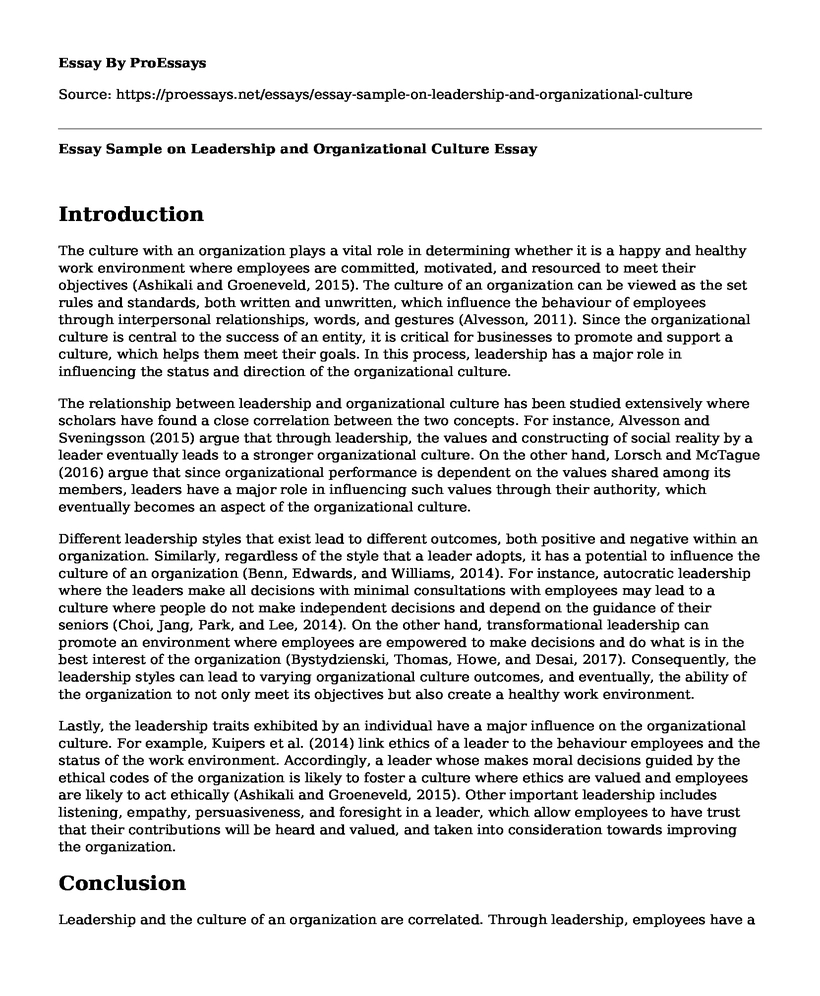Introduction
The culture with an organization plays a vital role in determining whether it is a happy and healthy work environment where employees are committed, motivated, and resourced to meet their objectives (Ashikali and Groeneveld, 2015). The culture of an organization can be viewed as the set rules and standards, both written and unwritten, which influence the behaviour of employees through interpersonal relationships, words, and gestures (Alvesson, 2011). Since the organizational culture is central to the success of an entity, it is critical for businesses to promote and support a culture, which helps them meet their goals. In this process, leadership has a major role in influencing the status and direction of the organizational culture.
The relationship between leadership and organizational culture has been studied extensively where scholars have found a close correlation between the two concepts. For instance, Alvesson and Sveningsson (2015) argue that through leadership, the values and constructing of social reality by a leader eventually leads to a stronger organizational culture. On the other hand, Lorsch and McTague (2016) argue that since organizational performance is dependent on the values shared among its members, leaders have a major role in influencing such values through their authority, which eventually becomes an aspect of the organizational culture.
Different leadership styles that exist lead to different outcomes, both positive and negative within an organization. Similarly, regardless of the style that a leader adopts, it has a potential to influence the culture of an organization (Benn, Edwards, and Williams, 2014). For instance, autocratic leadership where the leaders make all decisions with minimal consultations with employees may lead to a culture where people do not make independent decisions and depend on the guidance of their seniors (Choi, Jang, Park, and Lee, 2014). On the other hand, transformational leadership can promote an environment where employees are empowered to make decisions and do what is in the best interest of the organization (Bystydzienski, Thomas, Howe, and Desai, 2017). Consequently, the leadership styles can lead to varying organizational culture outcomes, and eventually, the ability of the organization to not only meet its objectives but also create a healthy work environment.
Lastly, the leadership traits exhibited by an individual have a major influence on the organizational culture. For example, Kuipers et al. (2014) link ethics of a leader to the behaviour employees and the status of the work environment. Accordingly, a leader whose makes moral decisions guided by the ethical codes of the organization is likely to foster a culture where ethics are valued and employees are likely to act ethically (Ashikali and Groeneveld, 2015). Other important leadership includes listening, empathy, persuasiveness, and foresight in a leader, which allow employees to have trust that their contributions will be heard and valued, and taken into consideration towards improving the organization.
Conclusion
Leadership and the culture of an organization are correlated. Through leadership, employees have a basis for their actions and underlying motivations for the actions, which are driven by the top management. Such influence could result in positive or negative organizational outcomes depending on the leadership style and traits of the leaders. Additionally, the traits of a leader also have an important influence on the behaviour of employees, and eventually, the culture. Consequently, an organization seeks to change its culture should put into consideration how its leadership can facilitate the process.
References
Alvesson, M. and Sveningsson, S., 2015. Changing organizational culture: Cultural change work in progress. Routledge.
Alvesson, M., 2011. Leadership and organizational culture. The SAGE handbook of leadership, pp.151-164.
Ashikali, T. and Groeneveld, S., 2015. Diversity management in public organizations and its effect on employees' affective commitment: The role of transformational leadership and the inclusiveness of the organizational culture. Review of Public Personnel Administration, 35(2), pp.146-168.
Benn, S., Edwards, M. and Williams, T., 2014. Organizational change for corporate sustainability. Routledge.
Boehm, S.A., Dwertmann, D.J., Bruch, H. and Shamir, B., 2015. The missing link? Investigating organizational identity strength and transformational leadership climate as mechanisms that connect CEO charisma with firm performance. The Leadership Quarterly, 26(2), pp.156-171.
Bystydzienski, J., Thomas, N., Howe, S. and Desai, A., 2017. The leadership role of college deans and department chairs in academic culture change. Studies in Higher Education, 42(12), pp.2301-2315.
Choi, S., Jang, I., Park, S. and Lee, H., 2014. Effects of organizational culture, self-leadership, and empowerment on job satisfaction and turnover intention in general hospital nurses. Journal of Korean Academy of Nursing Administration, 20(2), pp.206-214.
Jung, D.I., Chow, C. and Wu, A., 2003. The role of transformational leadership in enhancing organizational innovation: Hypotheses and some preliminary findings. The leadership quarterly, 14(4-5), pp.525-544.
Lorsch, J.W., and McTague, E., 2016. Culture is not the culprit. Harvard Business Review, 94(4), p.98-105.
Kuipers, B.S., Higgs, M., Kickert, W., Tummers, L., Grandia, J. and Van der Voet, J., 2014. The management of change in public organizations: A literature review. Public administration, 92(1), pp.1-20.
Cite this page
Essay Sample on Leadership and Organizational Culture. (2022, Jul 15). Retrieved from https://proessays.net/essays/essay-sample-on-leadership-and-organizational-culture
If you are the original author of this essay and no longer wish to have it published on the ProEssays website, please click below to request its removal:
- Paper Example on Perception and Individual Decision Making
- Fluctuation in Business Productivity Paper Example
- Case Study: Prada-New Perspectives on the Prada Group
- Jonathan Edwards' Spiritual Leadership - Essay Sample
- Prosecutor's Information Management System - Research Paper
- Paper Example on Designing Facilities for Optimal Healthcare: Stakeholder Perspectives
- Report Sample on Robin Hood & Band Of Merry Men: Challenges & Solutions







